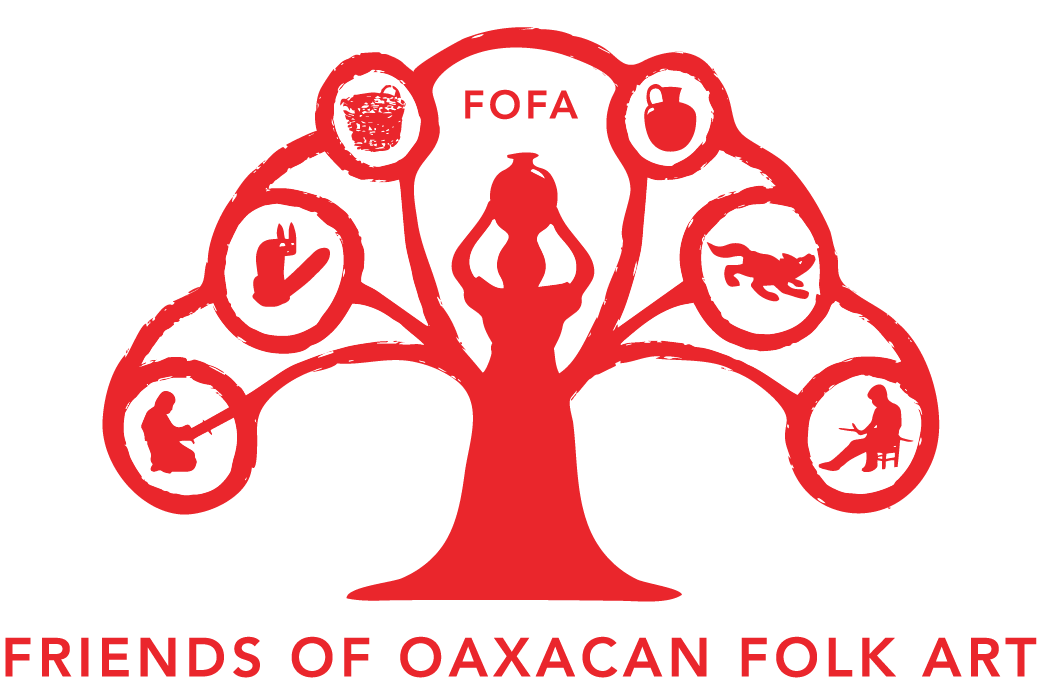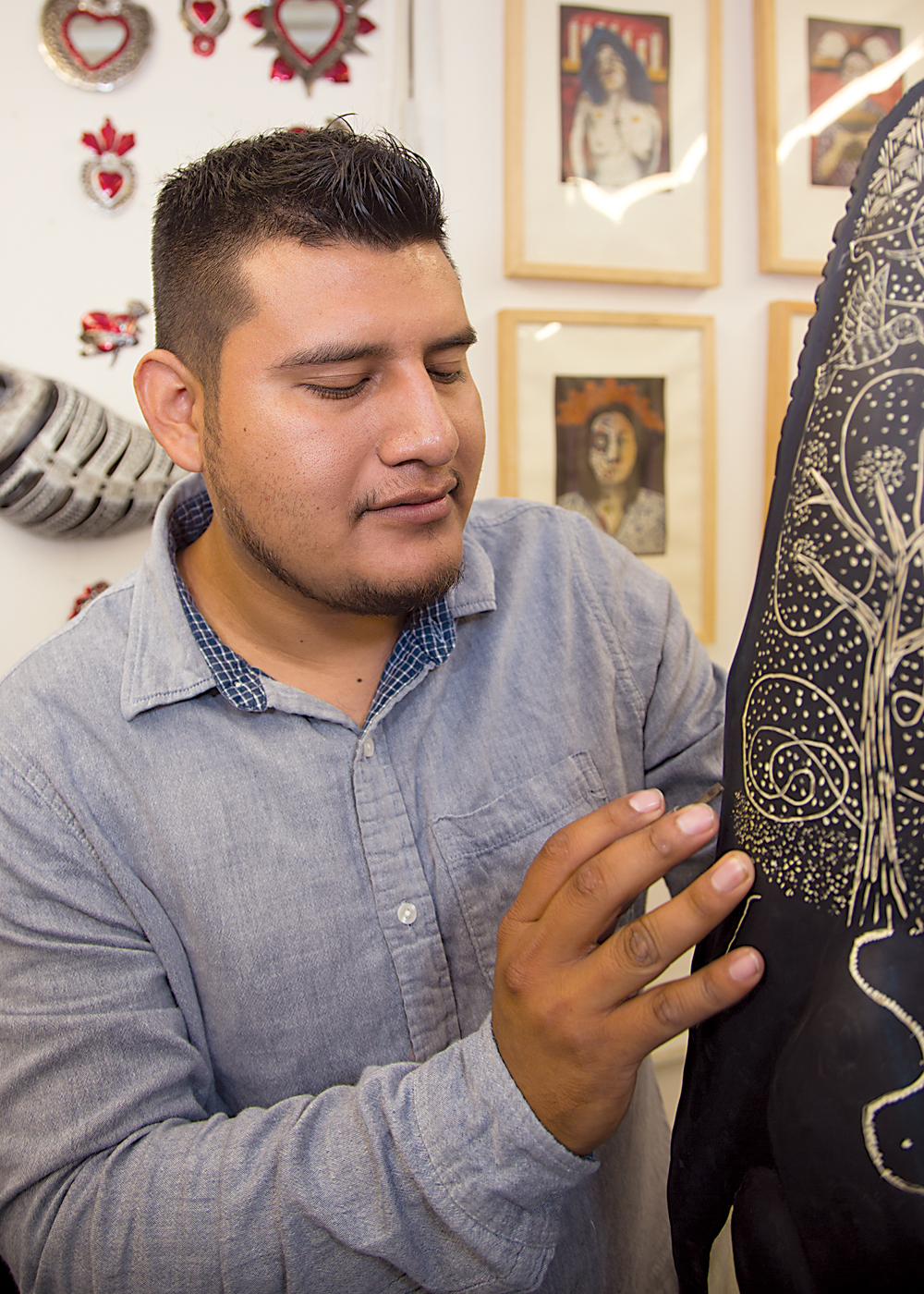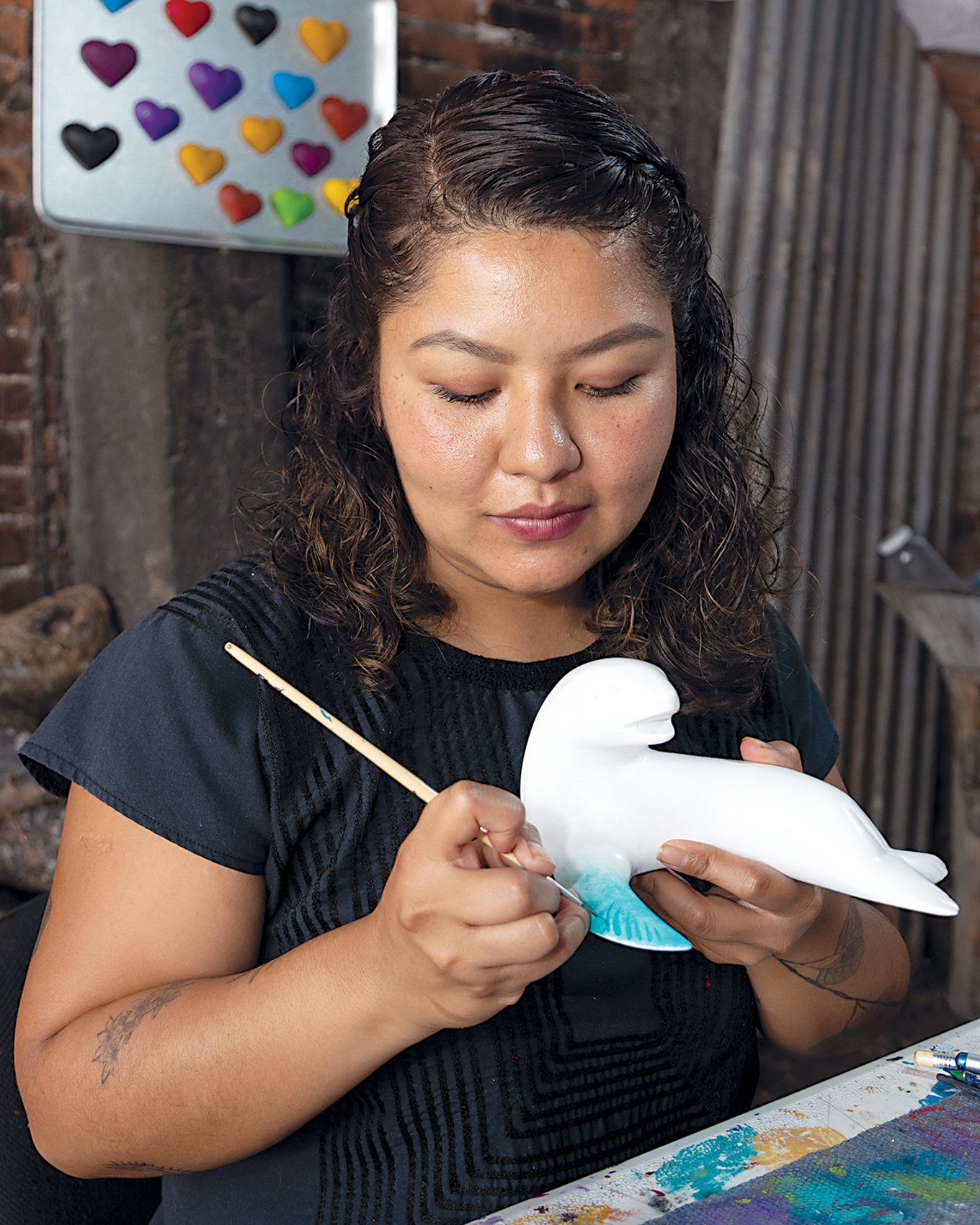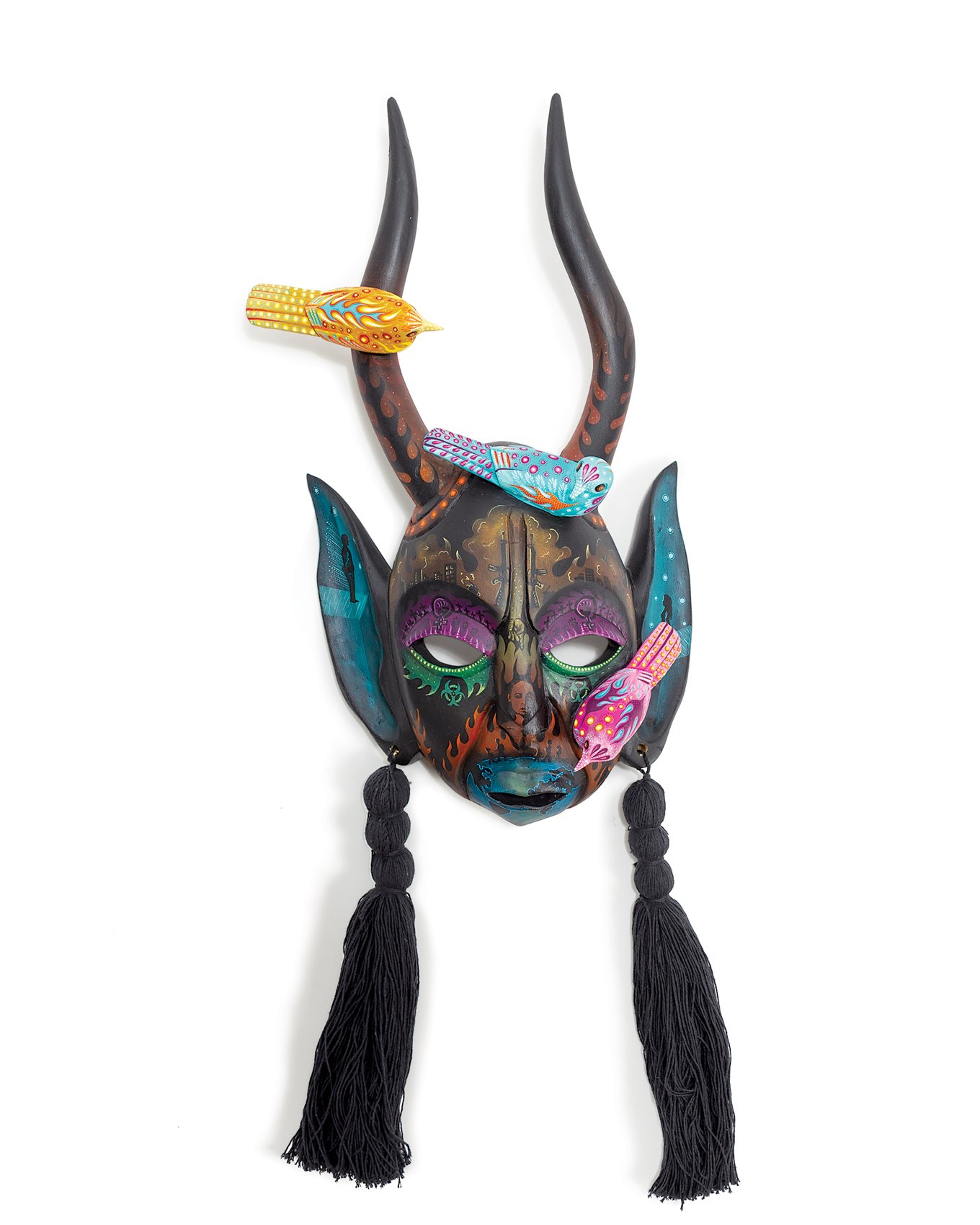meet the artists / woodcarving / woodcarving page 2 / woodcarving page 3 / woodcarving page 4
WOODCARVING
San Martín Tilcajete
María Jiménez Ojeda and her Four Brothers
Pueblo of San Martín Tilcajete
Calle Allende #10
florebrije@hotmail.com
(From US) Landline: 011-52-951-245-9105
Cell: 011-52-951-440-3724
(In Oaxaca) Landline: 245-9105
Cell: 951-440-3724
María creates enchanting and original painted designs for pieces carved by her brothers, Alberto, Arón, Miguel, and Cándido. She is best known for her delicate butterflies, doves, and rabbits, patterns that derive from her earlier work in embroidery. Many of the pieces produced by this family are unique in their painting and carved forms. These include sleek animals in graceful poses (such as a toucan with an exaggerated beak, and an elongated dog with a dramatically arched back) and a Virgin of Soledad. María regards carved angels with dramatically spread wings as her own special design, the carving of which is generally executed by her brother Arón. The family’s practice of artistic attribution is a departure from the regional tradition: male carvers sign regardless of who has decoratively painted the piece. In this family María alone signs the pieces she paints, while her brothers sign pieces that they or their wives decoratively paint.
Martín Melchor Ángeles
Pueblo of San Martín Tilcajete
Andres Portillo #2
mmelchoroc@gmail.com (daughter’s email)
(From US) Landline: 011-52-951-524-9010
(In Oaxaca) Landline: 524-9010
Martin learned to carve from his uncle, Coindo Melchor. His pieces are noteworthy for their playfulness and joy, both in content and bright decorative painting palette emphasizing primary colors. Giraffes ride in moto-taxis, with their necks protruding through the awning, while burros ride bicycles. Couples drink refreshing beverages seated at beach tables, and animals seated on chairs fish for the catch of the day. A recent innovation is figures performing the traditional dance of Zachiila, outfitted in clothing created by Martin’s wife.
Leonel Melchor Ojeda
[3rd prize in “Decorative painting of woodcarving,” FOFA’s 2018 contest]
Pueblo of San Martín Tilcajete
Galeana #09
arte.eljaguar_margarito@hotmail.com
(From US) Cell: 011-52-951-113-5128
(In Oaxaca) Cell: 951-113-5128
Leonel, a high school student interested in pursuing languages, comes from a multi-generational woodcarving family for whom the values of hard work and innovation are deeply held. For him, the hare reflects the same positive character traits that give his culture its strength: cleverness, adaptability, and perseverance. He feels that strength also comes from the abundance of the local natural environment. He painted his magnificent hare over a five-week period, applying multiple layers of an acrylic blend using different tools and brushes to create the varied textural elements. Leonel learned this unique technique from his father, who developed it after years of experimentation.
Giovanni Melchor Ramos
[Honorable mention in decorative painting of woodcarving, FOFA 2013, 2016, 2018 contests]
Pueblo of San Martin Tilcajete
1a Privada Tilcajete #7
giodibujante@gmail.com
(From US) Cell: 011-52-951-569-2102
(In Oaxaca) Cell: 951-569-2102
Giovanni’s piece, incorporating three animal figures, conveys the circle of life and evolution of folk art in his pueblo. His grandfather’s generation introduced decorative painting of woodcarving to San Martín Tilcajete. To honor him, Giovanni embellished a blue coyote with images used in earlier times, including clay masks, embroidery, and baroque flowers. The jaguar represents his father in carefully measured geometric forms created with wax and ink sgrafitto. The dog reflects Giovanni’s own distinctive style of using a matte base decorated with black and contrasting white points. A third generation artist, Giovanni began to draw at five years of age, learning from his parents. Having taken drawing classes, he also regards his teacher Carlos Rubio as an important influence, along with painters such as Dalí, Da Vinci and the Surrealist school. His dream is to encourage this folk art tradition in future generations.
Miguel Ángel Ortega Fabián
[2nd prize in “Decorative painting of woodcarving,” FOFA’s 2018 contest]
Pueblo of San Martín Tilcajete
Avenida Independencia #03
(From US) Landline: 011-52-951-524-9181
Cell: 011-52-951-416-1717
(In Oaxaca) Landline: 524-9181
Cell: 951-416-1717
Miguel Ángel chose a jaguar to symbolize the enduring strength of Oaxacan culture. For him, “the colors and designs represent different aspects of our history, environment and
daily life.” He began to decoratively paint at the age of 13. On the jaguar’s head, body and tail, the natural world is represented by a lush landscape of symbolic shapes, including hills, rivers, flowers, fish, and palm leaves. Blues and oranges convey happiness, and white the peacefulness of the pueblo. On the jaguar’s legs are the intricately laid out bricks of a church, in alternating red hues; Zapotec grecas create a unifying element throughout.
Marcos Sandoval Melchor
[Honorable mention in decorative painting of woodcarving, FOFA’s 2016 contest]
Pueblo of San Martín Tilcajete
Tilcajete #6
marsando112@gmail.com
(From US) Cell: 011-52-951-412-0035
(In Oaxaca) Cell: 951-412-0035
Marcos grew up around woodcarving and art. His father and uncles carved, and Marcos began painting at the age of six. His energetic imagination is captured in this starry-eyed rabbit with wings, carved by his uncle. The rabbit’s face is hidden behind a jade mask, “a reminder that this whimsical creature is but a representative surface on which to paint one’s dreams.” Marcos placed Zapotec symbols like grecas on the chest of the rabbit, skulls for the god of death, and corn for life. On the animal’s wings we see a vibrant montage of patterns including images of the region’s folk art: black pottery, embroidery, and weaving.
The Sosa Family
Jesús Sosa Calvo (brother of Francisca Calvo, listed above)
Pueblo of San Martín Tilcajete
Progreso #44
jesussosac_figmadera@hotmail.com
(From US) Landline: 011-52-951-524-9038
Cell: 011-52-951-116-2415
(In Oaxaca) Landline: 524-9038
Cell: 951-116-2415
Jesús, a pensive man, derives deep satisfaction from his art. He is never content to rest on his laurels, perpetually expanding his technique by taking courses, including in drawing, oil painting, and marionette-making in art schools in Oaxaca. He is best known for his reclining dogs and cats, but he also creates fabulous mermaids with long, flowing hair made of ixtle (a fiber from cacti), rabbits and burros. Some of Jesús‘s figures have moving parts, influenced by his studies in marionette making. He has also created two signature decorative ideas. One is painting the faces of his figures, as if masks, with variegated colors. The other is painting amoeba-like shapes on their bodies, as a result of noting their texture and configurations in scientific books he has studied.
Gabriel Sosa Ortega
[Honorable Mention in Woodcarving, FOFA’s 2018, 2022 contests]
Progreso #44, San Martín Tilcajete 71506
(To call from US, first dial 011-52)
Tel celular • Cell phone: 951-116-2415
Email: matlacihua_arte_2016@hotmail.com,
Facebook: Gabriel Sosa
Instagram: @gabrielsosao_
Gabriel’s grand woodcarving is his commentary on society as a whole, emphasizing the necessity of “inclusion,” the breaking down of barriers between people. He believes that “when we scratch the surface, we are all alike under the skin.” Inspired by the hard-working Oaxacan coastal community of African-American slave descendants that remains largely unrecognized by the larger society, he features a woman, with a composite of skin tones, growing out of a cactus. On her figure Gabriel conveys the strength of her people—who combine industriousness (fishermen) and pleasure in celebration and dance (the calenda)—with his remarkable engraving, pointillist painting, and incorporation of 58 other materials for decoration (e.g., corn kernels and cactus fiber).
Laura Sosa Méndez
[Honorable Mention in Decorative Painting of Woodcarving, FOFA’s 2011, 2016, 2022 contests]
Calle Cristal s/n Tocuela, Ocotlán de Morelos 71510
(To call from US, first dial 011-52)
Tel celular • Cell phone: 951-292-5831
Email: laura.peqe@hotmail.com
Facebook: Alebrijes Laura Sosa Mendez
Instagram: lauramendez9745
Laura was born and raised in the woodcarving pueblo of San Martín Tilcajete, but is self-taught as a painter. With nine years of experience, she handles her materials with precision and exuberance. The title of her piece is a play on words, understood as both a “royal dream” and a “real dream.” Her decorative painting of a piece carved by a friend is a celebration of technique and imagery, showing Zapotec symbols of water (blue circle), earth (green square), fire (red square) and air (yellow swirls), interspersed with cultural icons, Frida Kahlo and Oaxacan Guelaguetza dancers; the maguey and piña plants; and regional customs, occupations and art work – all cast whimsically on the body of a rhinoceros.
Inocencio Vásquez Melchor
Pueblo of San Martín Tilcajete
Allende #1
(From US) Cell: 011-52-951-164-0030
(In Oaxaca) Cell: 951-164-0030
Inocencio is the creator of several distinctive styles of carved and painted wooden pieces. He is best known for his borrachos (drunkards) often in the ironic form of angels, his human-like devils, and human or human-animal nahual musicians. In Inocencio’s pueblo, residents enjoy recalling the traditional belief that ordinary people can turn themselves into animals at night, particularly when there is a full moon. Many of Inocencio’s creations lend themselves to assemblages, such as four drunken angels or four devils seated on individually carved chairs around a table, or skeleton dancing partners. Another is a band composed of musicians in varied poses such as a marimba trio. Many of Inocencio’s figures have articulated joints, one of his signature features. He prides himself most on his jointed devils.
The Xuana Family
This productive woodcarving family consists of three brothers and their many children; each brother lives in his own home with his spouse and their children. Also untraditional are the practices of some women carving and both men and women decoratively painting the woodcarvings produced. The three brothers were inspired by Isidoro Cruz, one of the original woodcarvers of their pueblo, who invited them to initiate this work. Some members of the family specialize in creating a spectrum of miniatures ranging from charming and rustic to extremely delicate.
Justo Xuana Luis (brother of Abad)
Pueblo of San Martín Tilcajete
Avenida Galeana #6
(From US) Landline: 011-52-951-524-9204
Cell: 011-52-951-329-1138
(In Oaxaca) Landline: 524-9204
Cell: 951-329-1138
Justo is known for his whimsical miniature woodcarved figures, work he began in 1995. A mother giraffe seated on an armchair reads a story to her attentive baby giraffe, while a band of trumpet players is composed of a lively upright wolf, dog and anteater. He also specializes in nativity scenes both in miniature and an array of larger sizes, priding himself on his carving of the faces of the Three Kings. As progress is very important to him, he takes great pleasure in creating new pieces.
Justina Xuana Fabian
[Winner in decorative painting of woodcarving, FOFA 2008 contest]
Unlike her family members, all of whom are in San Martín Tilcajete, Justina lives close to Ocotlán de Morelos in Santa Rosa de Lima
Díaz Ordaz 106
(From US) Cell: 011-52-951-102-0377
(In Oaxaca) Cell: 951-102-0377
Each year, usually between January and March, Justina’s pueblo celebrates Carnival, a very important tradition. This inspired her to create the “Devil’s Mask,” a piece she carved with the assistance of her father and teacher, Justo Xuana, and painted herself. It embodies many elements that reflect her origins. The horns are represented by birds, while the mouth is the beak of an eagle, and the cheeks are formed by a cat and a panther. Justina seeks to convey the occult and the mysterious with this mask.
Martin Xuana Fabián (son of Justo)
[Honorable mention in woodcarving, FOFA 2016 contest]
Pueblo of San Martín Tilcajete
Avenida Galeana #6
xua.art2015@gmail.com
(From US) Landline: 011-52-951-524-9204
Cell: 011-52-951-329-1138
(In Oaxaca) Landline: 524-9204
Cell: 951-329-1138
Taught by his father to carve, Martín captures symbolic elements of life in his pueblo. The old man transmits his knowledge to the younger generation, as Martín’s father Justo and all carvers do for their children, friends, and all close to them. Martín’s innovation is sanding his piece after painting to achieve a matte effect. The bench represents the surface on which woodcarving is realized, as well as woodcarving’s position as the economic foundation that maintains families. The machete -the carver’s principal tool – conveys the capacity to actualize this art. Martín painted the base of his piece green to capture the beauty of Oaxaca, formerly known as Verde Antequera, the Ancient Green Region.
Abad Xuana Luis (brother of Justo)
Pueblo of San Martín Tilcajete
Avenida Galeana #5
(From US) Cell: 011-52-951-288-0015
(In Oaxaca) Cell: 951-288-0015
Abad’s work varies with the time of year. He carves skulls during the Day of the Dead, nativity scenes for Christmas, and masks for carnivals. Throughout the year he creates carts and smaller animal musician figures. He began to carve at 25 year of age, taught -- with his brother Justo -- by their uncle, master carver Isidoro Cruz, who specialized in masks.
Ana Xuana Velasco (miniatures)
Pueblo of San Martín Tilcajete
Avenida Galeana #5
(From US) 011-52-951-222-9429
(In Oaxaca) Cell: 951-222-9429
Ana carves fine miniatures, specializing in masks, animals, and mermaids – some mounted as earrings. Many of her family members carve, but she is the only one who devotes herself to miniatures. The delicacy of her painting also distinguishes her work.
Santa María Atzompa
(Victor) Ángel García Vásquez (son of Angélica Vásquez Cruz and husband of Josefina Claudia Martínez Alarzón)
[Honorable mention in decorative painting of woodcarving, FOFA’s 2008 contest]
Pueblo of Santa Maria Atzompa
Independencia #637
galarcult@yahoo.com
(From US) Landline: 011-52-951-558-9061
Cell: 011-52-951-212-1087
(In Oaxaca) Landline: 558-9061
Cell: 951-212-1087
Since 16 years of age Ángel has dedicated himself to carving and painting sculptures from a single piece of wood. Carving and painting wood is unusual for a resident of his pueblo, Santa María Atzompa, well known for its variety of ceramics. Ángel also collaborates with his wife, Josefina Claudia Martínez Alarzón, in creating ceramic pieces. In this carving, “Nymph and Chimera,” Ángel explains that the main figure, the nymph, represents the balance of nature, and each image surrounding her and painted on her skirt symbolizes one of its aspects. The wolf embodies secrecy and intelligence, the lion strength, the tiger patience and calm, the macaw the wind, and the snake represents the earth and all its secrets. Ángel painted his piece with his own personal blend of natural tints, clay earth pigments, acrylic and oil. He finishes with a coat of lacquer to create its sheen.
Emanuel Torres Ortiz
[Honorable mention in decorative painting of woodcarving, FOFA’s 2016 contest]
Pueblo of Santa María Atzompa
Carretera a Atzompa #502 Colonia Oaxaca
pegasosforever@hotmail.com
(From US) Cell: 011-52-951-229-8914
(In Oaxaca) Cell: 951-229-8914
Around the time he turned age eight, Emanuel’s parents taught him to work in woodcarving. Aware of the scarcity of the copal tree, he uses other types of wood. Emanuel dreams of being one of the best craftsmen and of bequeathing a personal style. He knows that he has to strive, dedicate himself, take courses, participate in more competitions and, if possible, receive support to make his pieces known. He decided to create "Grasshopper," for which he received honorable mention in FOFA’s 2016 young artists’ competition, because it is both an insect representative of the state and it is important in Oaxacan gastronomy. This piece required twenty days of work, including preparation of the wood, carving and painting.
Santa Cruz Xoxocotlán
Ángel Omar Rosales Canseco
[Honorable mention in Woodcarving, FOFA’s 2018 contest]
Pueblo of Santa Cruz Xoxocotlán
Aldama #71
engel_eros@hotmail.com
(From US) Landline: 011-52-951-517-0853
Cell: 011-52-951-359-5324
(In Oaxaca) Landline: 517-0853
Cell: 951-359-5324
On a single pochote thorn, Ángel has captured in miniature the entire celebration of Witches’ Tuesday, a traditional village party that takes place every Tuesday in Lent. Tamale makers come from the countryside to sell at night with their oil lamps called “little witches.” The detail in Ángel’s carving captures the music, the traditional dances, the theater and the food in the town square. Both the hard work of the day and the evening celebration are shared by all. Ángel believes that the strength of the people is in such traditions and the stories of their grandparents.
Carolina Sandoval Melchor
[Honorable Mention in Decorative Painting of Woodcarving, FOFA’s 2022 Contest]
Libertad #5, Santo Tomás Jalieza 71507
Cell phones: (From US) 011-52-951-403-5639
011-52-951-394-6366
(In Oaxaca) 951-403-5639/951-403-5639
Email: gica.oax@gmail.com
Instagram: gica.oax
Through a devil’s mask colored in dark tones and infernal flames, Carolina depicts the many evils facing the world today, such as war, immigration, discrimination, racism, gender violence, pollution, and pandemics. Invading this darkness are brightly colored doves, symbols of peace and hope. With this work, Carolina wishes to raise awareness and to begin a dialogue that can lead to the resolution of these conflicts and create an atmosphere of understanding and cooperation. These are values she shares with her husband, carver of the piece, that are embodied in their collaboration in the creation of this work, as well as in their everyday lives.







































